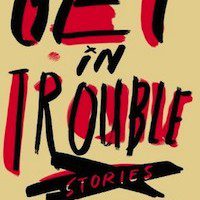Kelly Link writes about the world next door. Her stories don’t give ordinary life a single magical turn—a collegiate assessor’s nose running away from his face, for example, or a pickle seller coming to life after being brined for two generations—nor do they very often create entirely fantastical worlds. Instead, she twists reality just enough to make it both familiar and utterly strange.
Take the mermaids in “Light,” a masterful story from Link’s new collection Get in Trouble. They’re not enticing, they’re a nuisance. They foul the waters of the grottos in the Florida Keys. When the owners of the ponds install filters to keep the water clear, the mermaids, preferring the muck, tear them out. Their eerie songs depress the tourists. The only solution is to pipe in elevator music. Ironically, the grotesque qualities of Link’s mermaids make them real. If mermaids existed, this is how they would behave.
The mermaids in “Light” are also the perfect symbol for the troubled life of that story’s alcoholic protagonist, Lindsey, who, when she isn’t drinking herself into oblivion and arranging one-night stands, manages a warehouse that stores “sleepers,” — comatose men and women increasingly discovered in forests, caves, and construction sites. Lindsey is trying to hold her life together as a hurricane bears down on Florida. “Light” is a dark story about things falling apart, about a center that cannot hold. What could be better, in a story about the broken promise of the world, than a pestilence of mermaids?
If Link’s realistic settings and elegant metaphors push her fantastical stories toward the realm of literary fiction, so do her characters, structures, and themes. “The Faery Handbag,” the first story in her 2005 collection Magic for Beginners, featured Zofia, a two hundred year-old grandmother from the vanished Eastern European country of Baldeziwurlekistan. Zofia left her Baldeziwurleki village shortly after it packed itself into a dogskin handbag to escape a raiding party. Now she regales her granddaughter Genevieve with stories about the village in her purse, how its residents cast lettered tiles onto boards to divine the future and communicate with a subterranean community where time stands still. Shortly after Zofia appoints Genevieve guardian of the handbag, Genevieve’s boyfriend Jake disappears into it. Then, in the commotion surrounding Zofia’s death, the handbag disappears, leaving Genevieve to search for it and her lost love. Slowly, over the course of its loosely connected scenes, “The Faery Handbag” reveals itself as a tale about the transcendent power of magical storytelling, the idea that a shining lie can tell the truth. It’s a fantastical story about the power of language, in other words, structured and told in classic New Yorker realism style.
This stylistic confluence in Link’s work makes her voice unique. We actually expect fantastical stories to be easy to follow. Link’s stories, like good realist fiction, can be hard to piece together. Often as I was reading Magic for Beginners I wondered what, exactly, the stories I was reading were about.
Link’s achievement in Get in Trouble is to more artfully arrange the magical elements of her stories into their realist frames. Her new collection is just as marvelous as her earlier work, but its stories draw the reader in more easily. The stakes in them are easier to see. Because their magic rests more comfortably within their well-developed realist narratives, they are more compelling to read.
“The Summer People,” for example, reads like a Shirley Jackson story. Fran’s father has departed for a prayer meeting in Miami, leaving her as the caretaker for the summer residents of his guest cottage. The strange details in Fran’s encounters with the summer residents suggest dark machinations behind the veil of daily life. On the other hand, it might just be her fever and the Nyquil she’s been drinking. That ambiguity—the fact that the spooky things Fran glimpses might be all in her mind—makes the story more believable and more doubtful at the same time and as a result, more chilling.
The magical elements in “Origin Story,” about two high school lovers reuniting in a broken- down Wizard of Oz theme park on a mountainside, stand in as metaphors for the lost glow of youth. When Bunnatine returns home in the morning to attend to her baby girl, it’s like she has tapped her ruby slippers together and returned to Kansas. “Two Houses,” a Victorian ghost story told as science fiction, is surprisingly realistic, creepy, and magnificently strange.
Whether you like Get in Trouble more than Link’s earlier collections may be a matter of taste. I didn’t fall for “Secret Identity,” in which two virtual gamers arrange a real-life meet-up, or “The New Boyfriend,” which explores the possibilities of boyfriend robot love. But I admired and enjoyed the other stories, and in the best of them I was awed by Link’s high mastery of her form. The press materials that came with my copy of Get in Trouble touted it as Link’s finest book yet, and while I naturally doubted that claim, I am here to tell you that it’s true. If, for some reason, Link’s earlier fiction didn’t grab you, Get in Trouble will. If you liked her earlier work, you will, I predict, love her new collection even more.





